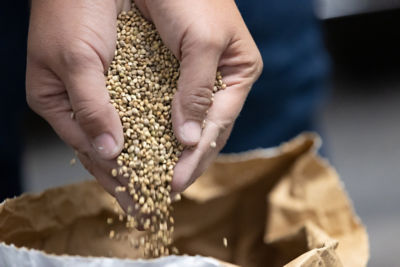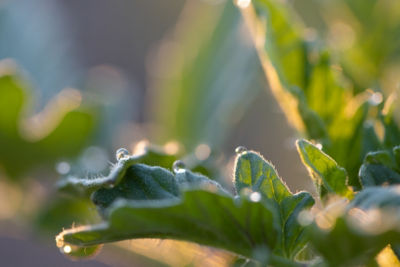Click here to download a PDF version of this spotlight.
- Irrigation of vegetable crops is used to provide uniform soil moisture at levels needed for crop growth and development.
- Irrigation requirements vary with the soil properties, environmental conditions, and crop type and stage of development.
- Irrigation systems vary in their application efficiencies, which impacts the amount of water that needs to be applied.
It has been said that “vegetables are nothing but nicely packaged water,” which emphasizes the importance of water management in vegetable crop production.1 Optimal vegetable production depends on the appropriate and timely availability of water during the cropping season. This usually requires the use of irrigation even in areas where regular rainfall is common.
 Figure 1. A sprinkler gun irrigation system.
Figure 1. A sprinkler gun irrigation system.
Irrigation Systems
Irrigation systems used for vegetable crop production include surface irrigation (furrow, seepage, flood), overhead irrigation (Figure 1), and drip irrigation. Irrigation systems should be designed to prevent water stress in the crop, but also to avoid the excess application of water, which can leach nutrients out of the root zone. The need for efficient irrigation systems that minimize the loss of water has increased as the costs of water have risen, and the availability of water has declined in many areas.
Although irrigation is used primarily to supply the water necessary for crop growth and development, water applications can also serve other purposes including wetting soils for field preparation, crop establishment (seed germination), application of fertilizers and pesticides, dust control, and frost protection. In some operations, different irrigation systems are used to meet these different needs. For example, sprinkler irrigation may be used at the beginning of the season to facilitate seed germination and seedling establishment. Once the crop is established, drip irrigation is used to supply the water needed for crop growth and development for the remainder of the season.
The amount of water that needs to be applied to the crop is called the irrigation requirement (IR). Water use efficiency or application efficiency (AE) is the fraction of the water applied that is available to the plant. Water losses from evaporation or wind drift, surface runoff, deep percolation out of the root zone, and leaks in irrigation pipes lower the AE of the system.2 Surface (furrow, flood, seepage) irrigation systems have AEs between 20 and 70% (over 50% if tailwater is recovered). Overhead sprinkler systems have AE values of 60 to 80%, and drip systems have AE values of 80 to 95%.2 The amount of water that a crop needs for proper growth and development is referred to as the evapotranspiration requirement of the crop (ETc). The ETc varies with the type of crop, the growth stage of the crop, and the evaporative demand of the crop, which is affected by temperature, humidity, and wind. The crop canopy size, plant population, method of irrigation, and soil type also influence the ETc level.3 The ETc for a crop is calculated by multiplying the base evapotranspiration value (ETo) by a crop coefficient (Kc) using the formula ETc =ETo*Kc. The ETo value is based on the amount of water that evaporates from a uniform green surface. Kc values vary with the crop, stage of growth, and the cropping system (bare ground vs. mulched) and region. The Kc value repersents the fraction of the ET of a fully-irrigated reference crop that is used by the actual crop. So if the Kc of a specific crop at a specific growth stage in a specific region is 0.45, then the crop will use about 45% of the ET of the fully irrigated reference crop. Typical ETo and Kc values (Tables 1 and 2) are vailable in some vegetable growing regions from agencies such as UF-IFAS and the California Department of Water Resources.2,3 Estimates of ETo can also be made directly in the field using monitoring equipment. The irrigation requirement (IR) is then calculated by dividing the ETc value by the application efficiency (AE) value for the irrigation system, IR=ETc*AE. If a crop required 1 inch of water per week to grow, the grower would need to apply 2 inches of water using a furrow irrigation system with an AE of 50%, 1.4 inches of water using a sprinkler system with an AE of 70%, and 1.1 inches of water using a drip system with an AE of 90%. The goal of water management is to apply the required amount of water at the appropriate time.


Applying too little water when it is needed leads to plant stress and potentially lower yields. Early-season water deficits can delay plant maturity and reduce production. Late-season deficits can reduce yield and product quality. Applying too much water is a waste of water and money. Too much water also leaches nutrients out of the root zone, can increase the severity of root diseases, and can result in reduced yield and product quality.2,4,3

Figure 2. An example of irrigation management to keep soil moisture levels in the desired safe irrigation zone. Rainfall events may eliminate the need for a scheduled irrigation, but soil moisture levels should be monitored to ensure that levels do not drop to the point where plants become stressed.2
Irrigation Scheduling
Irrigation should be applied to keep water levels in the root zone between the soil’s field capacity (the maximum amount of water that the soil can hold) and the point at which plants start to be stressed from a lack of water, the range of soil moisture levels called the “safe irrigation zone” (Figure 2).2 The frequency and amount of irrigation needed to keep moisture levels in the safe irrigation zone depend on the water holding capacity and infiltration rates of the soil, weather conditions, and crop demands.2 Rainfall levels should also be factored into determining the need for irrigation in non-mulch systems. In systems using plastic mulch, the mulch can prevent most of the rain-water from reaching the root zone, and rainfall contributes little to meeting the water requirements of the crop, especially on sandy soils. In soils with low water holding capacities, the calculated volume of water needed per day may be more than the soil can hold. In this case, irrigation events should be split over the day so that the amount of water added per application does not exceed the maximum amount that the soil can hold. If conditions require the application of 5,000 gallons of water per acre per day, but the maximum water application for the soil is 2,000 gallons, then the water will need to be applied over at least three applications.
Sources
1 Ozores-Hampton, M., McAvoy, E., Muchovej, R., Hanlon, E., Shukla, S., and Roka, F. 2017. Management of soil and water for vegetable production in southwest Florida. University of Florida IFAS Extension Publication #SL-233. https://edis.ifas.ufl.edu/ss452.
2 Zotarelli, L., Dukes, M., Liu, G., Simonne, E., and Agehara, S. 2018. Principles and practices of irrigation management for vegetables. 2018 Vegetable Production Handbook. UF-IFAS.
3 Snyder, R. and Pruitt, W. 1992. Evapotranspiration data management in California. In Irrigation and Drainage: Saving a Threatened Resource – In Search of Solutions, Proceedings of the Irrigation and Drainage Sessions at Water Forum ‘92.
4 University of Massachusetts. 2013. Irrigating vegetable crops. https://ag.umass.edu/vegetable/fact-sheets/irrigating-vegetable-crops.
Websites verified 2/14/2019
For additional agronomic information, please contact your local seed representative.
Performance may vary from location to location and from year to year, as local growing, soil and weather conditions may vary. Growers should evaluate data from multiple locations and years whenever possible and should consider the impacts of these conditions on the grower’s fields. The recommendations in this article are based upon information obtained from the cited sources and should be used as a quick reference for information about irrigation and water management. The content of this article should not be substituted for the professional opinion of a producer, grower, agronomist, pathologist and similar professionals dealing with vegetable crops.
SEMINIS DOES NOT WARRANT THE ACCURACY OF ANY INFORMATION OR TECHNICAL ADVICE PROVIDED HEREIN AND DISCLAIMS ALL LIABILITY FOR ANY CLAIM INVOLVING SUCH INFORMATION OR ADVICE. 9000_S1 Published 03-07-2019
Seminis® is a registered trademark of Bayer Group. All other trademarks are property of their respective owners. © 2019 Bayer Group. All rights reserved. better



